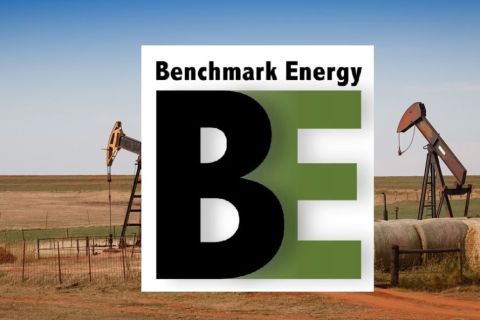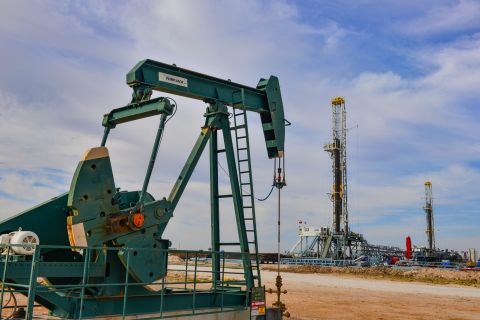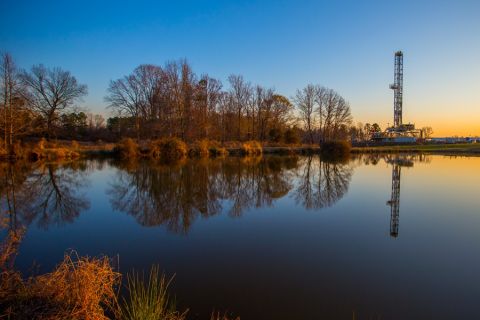Presented by:

This article appears in the E&P newsletter. Subscribe to the E&P newsletter here.
Over the past decade, more than 90,000 horizontal wells have been drilled in major unconventional shale oil and gas plays, changing global markets. Technology has changed dramatically during this period, pushing production rates and reserves up while reducing costs to complete ever longer, multi-stage fractured wells. Yet the rapid growth in drilling and production resulted in an investor capital loss of a half trillion dollars between 2015 to 2019 (1).
Yet, projected recovery factors remain lower than 10%-15% of original hydrocarbon in pace. To combat these challenges, EOR techniques have been trialed in unconventional reservoirs, including gas and large chemical injection. However, in the current market situation where future hydrocarbon demand remains uncertain, sustainability is being highly scrutinized, and most importantly capital discipline is being demanded of public U.S. shale-focused companies, expensive and risky EOR techniques are unlikely to be adopted in the short term.
In addition to a more disciplined drilling strategy, a focus on cost-effective incremental improvements in existing unconventional production and reserves is critical. This approach is being achieved by enhancing hydrocarbon flow through near wellbore treatments, reducing the effects and/or remediating damage from child and parent well interactions, and cleaning up specific downhole damages.
Patent pending rigless chemical technology processes from Kairos Energy Services combines specialty chemistry and a diversion package that can be applied without mechanical intervention to improve production by 30%-60%, increase estimated ultimate recoveries (EURs) by 20%-30%, and deliver payback in less than six months. The chemistry package is customized to each application and designed to improve hydrocarbon relative permeability, remove water block and target specific damages. The use of the engineered diversion package has shown the ability to distribute the injected fluids along one to two-mile laterals, preventing the bulk of the fluid from exiting the most conductive fracture clusters.
This process was first trialed one year ago and has since been applied into four broad categories: production enhancement, frac hit remediation, enhanced frac protects or prefills and specific damage remediation.
Production enhancement is defined as improving production and reserves on mature unconventional wells. These wells are approximately two or more years old and are at or below type-curve. Although these wells represent the largest market, they are also in need of the most development. The primary mechanisms addressed are improvement in hydrocarbon relative permeability, reducing capillary pressure, and remediating damage within the wellbore. A recent application in the Eagle Ford demonstrated a production increase of 35% and payback in four months.
Frac hits, negative interaction between existing wells (parent) and newly fractured wells (child), have been of intense interest in the industry due to the potential degradation of production to both the parent and child wells. One study across five major shale basins found wells experiencing frac hits had a negative impact 40% of the time, on average (2). An internal analysis on a set of parent wells in the Eagle Ford found, on average, cumulative oil production reduced by 9% and cumulative gas production reduced by 32% six months post-frac hit.
The sustained damages to parent wells are primarily attributed to the large influx of water into depleted pore spaces and fractures, resulting in increased capillary pressure and water saturation, inhibiting hydrocarbon production. A parent well in the Eagle Ford lost an estimated 75% of its EUR after taking a frac hit with sustained changes in water-cut and gas-to-oil ratio. A proprietary chemical package composed of a nanoparticle and surfactant blend, solvent, and synthetic acid was designed to address water block, organic deposition, and minor scale damage. A total of 10,000 bbl was injected over 10 stages with the diversion package being deployed between each stage. The treatment increased oil production by 60%, resulting in a 30% improvement in the boe EUR and paying back in just under four months (Figure 1).
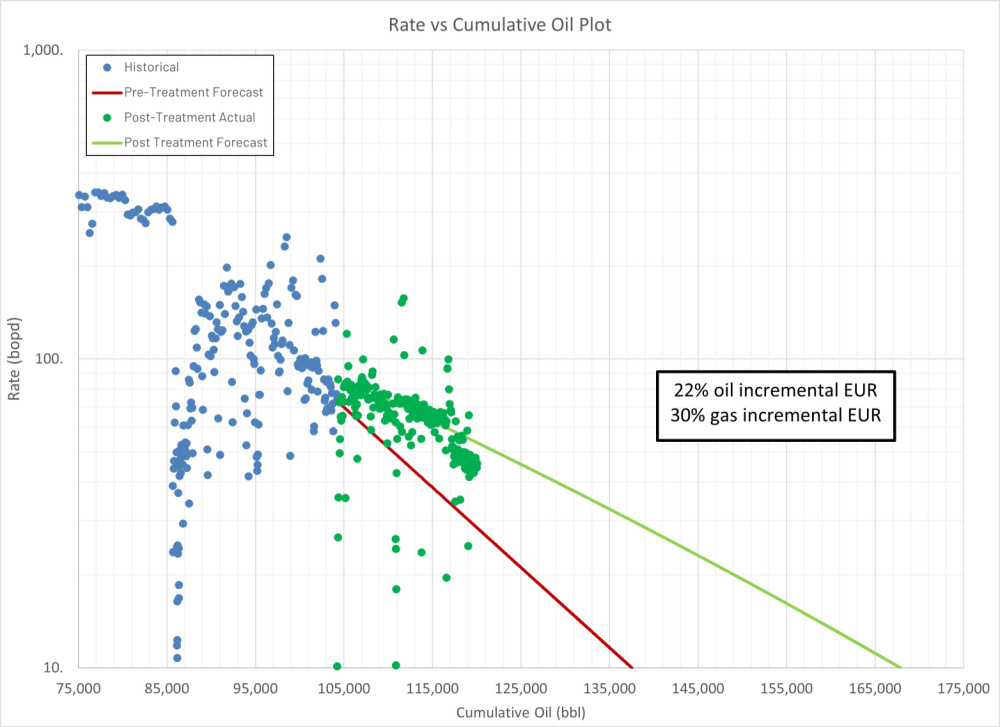
In addition to remediating damage from a frac hit, it is possible to protect parent wells. Strategies to protect parent wells vary widely; however, many operators attempt preloads or frac protects which involves injecting water to pressure up the pores, immediately surrounding the fractures and reducing the likelihood of fracture growth toward the parent well from the child well. The use of the rigless enhanced prefill has multiple benefits: the chemistry will improve production, mitigate the damage associated with injecting water, and build more bottomhole pressure per barrel injected through the use of the diversion package. Enhanced frac prefills performed on two wells in the Eagle Ford showed on average 185% more pressure per barrel injected versus wells that did not use diversion. The production results are still being evaluated.
A recently fractured horizontal well in the Powder River Basin produced sporadically before a black gel-like substance blocked off the pump, reducing all productivity. It was determined the substance was the friction reducer which had been crosslinked by iron from the formation, also known colloquially as “gummy bears.” A chemical package was developed that economically dissolved and dispersed the gummy bears while also improving hydrocarbon relative permeability. A total of 2,700 bbl were injected over eight stages and the well was returned to production, sustaining an oil production rate of 350 to 400 bbl/d over the past six months (Figure 2).
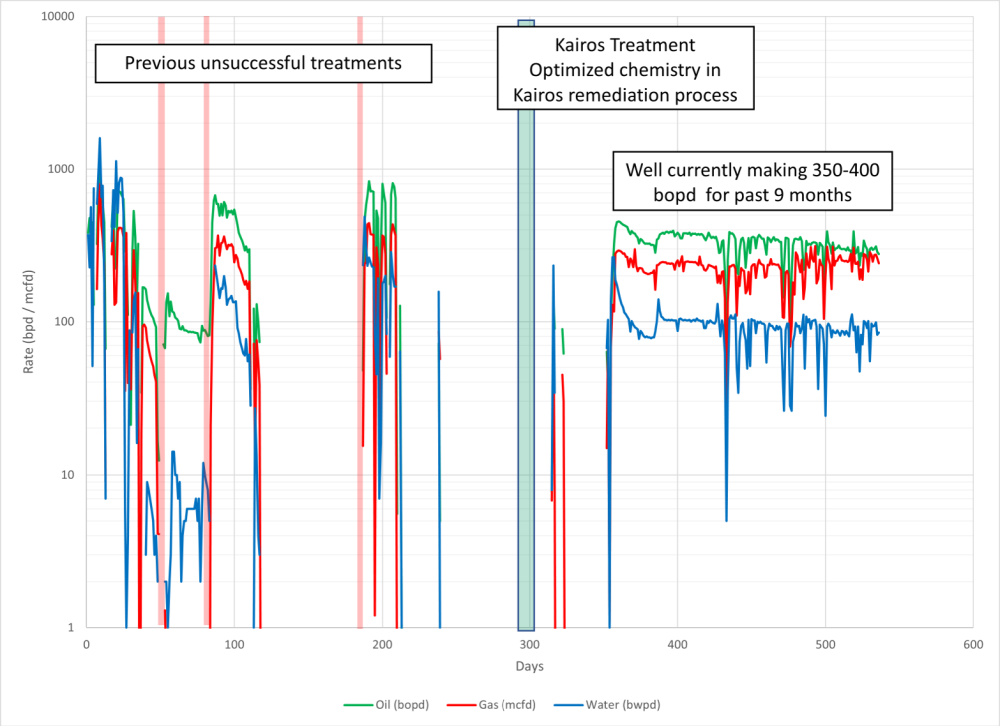
These four applications from Kairos Energy Services demonstrate the opportunity to significantly improve production and reserves from the large inventory of existing unconventional wells while delivering the required short cycle economics. Continued progress and scaling of these different types of applications will result in increased profitability from base production, an improved sustainability profile, and aid in meeting the growing energy demand.
- https://www.businessinsider.com/us-shale-oil-industry-vaporized-money-before-energy-markets-collapsed-2020-5?op=1
- Production Performance of Infill Horizontal Wells vs. Pre-Existing Wells in the Major US Unconventional Basins. G.. Lindsay; G.. Miller; T.. Xu; D.. Shan; J.. Baihly. 2018. https://doi.org/10.2118/189875-MS

About the author: Michael Lantz is the co-founder of Kairos Energy Services and a vice president of technical applications at Finoric LLC.
Lantz has over 13 years of experience in maximizing hydrocarbon recovery from conventional and unconventional reservoirs. This includes the design and application of EOR technologies, stimulation fluids, oilfield chemistry, and remedial processes. He holds a BSc in Chemical Engineering from the Colorado School of Mines and a MSc in Energy Management from the University of Colorado.
His colleague, Tom Burghart, also helped with this article.
Recommended Reading
EIA: Permian, Bakken Associated Gas Growth Pressures NatGas Producers
2024-04-18 - Near-record associated gas volumes from U.S. oil basins continue to put pressure on dry gas producers, which are curtailing output and cutting rigs.
Benchmark Closes Anadarko Deal, Hunts for More M&A
2024-04-17 - Benchmark Energy II closed a $145 million acquisition of western Anadarko Basin assets—and the company is hunting for more low-decline, mature assets to acquire.
‘Monster’ Gas: Aethon’s 16,000-foot Dive in Haynesville West
2024-04-09 - Aethon Energy’s COO described challenges in the far western Haynesville stepout, while other operators opened their books on the latest in the legacy Haynesville at Hart Energy’s DUG GAS+ Conference and Expo in Shreveport, Louisiana.
Mighty Midland Still Beckons Dealmakers
2024-04-05 - The Midland Basin is the center of U.S. oil drilling activity. But only those with the biggest balance sheets can afford to buy in the basin's core, following a historic consolidation trend.
Mesa III Reloads in Haynesville with Mineral, Royalty Acquisition
2024-04-03 - After Mesa II sold its Haynesville Shale portfolio to Franco-Nevada for $125 million late last year, Mesa Royalties III is jumping back into Louisiana and East Texas, as well as the Permian Basin.


